Abstract
Aqueous extracts of silage samples from four farms in up-state New York were reacted in vitro with normal human serum. Hemolytic levels of complement component C3 were consumed in a dose-dependent fashion, and the four extracts differed in their relative activity rankings. Studies with chelated serum indicate that the alternative complement pathway is involved in the activation, and the active fragment C3b was demonstrated. Serum levels of hemolytic C3 and C4 in vivo were quantified before and after farmers performed their normal silo unloading operations. Although the study groups were small, suggestive evidence of in vivo complement consumption was found. IgE-related allergy did not appear to be of significance to the study groups. Complement activation may be an initiator of or contributor to adverse reactions in farmers who are exposed to airborne silage dusts.
Full text
PDF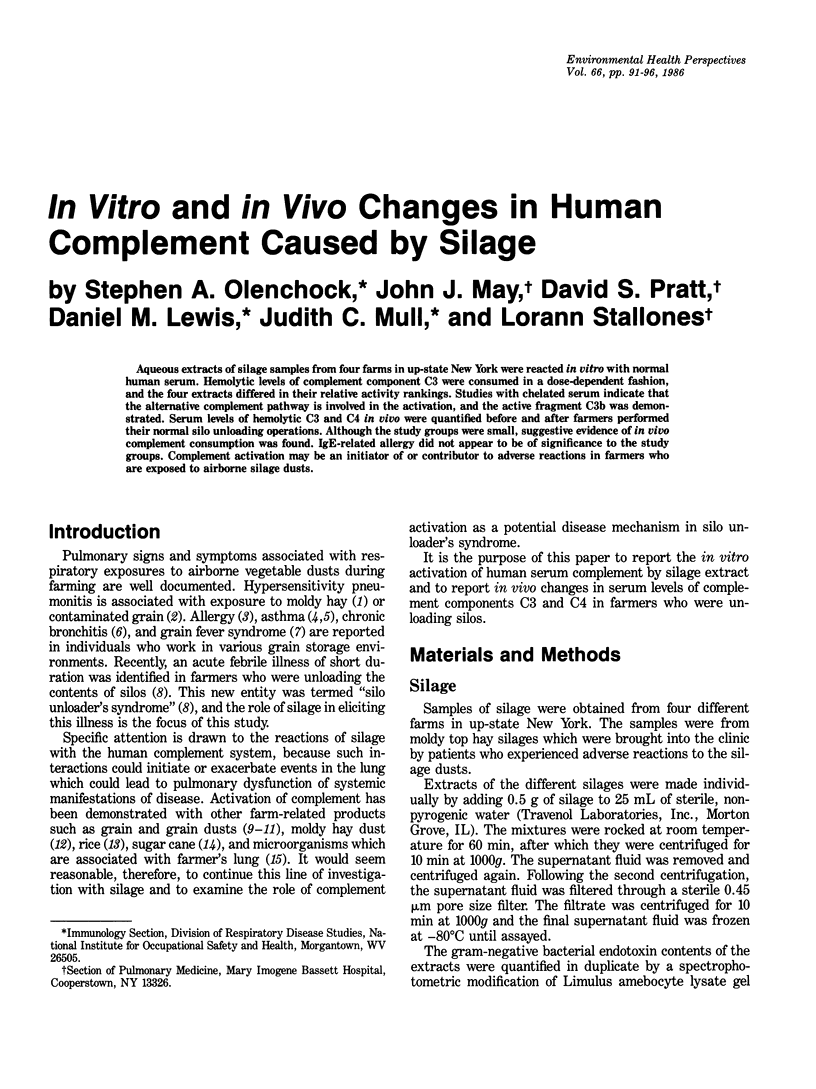
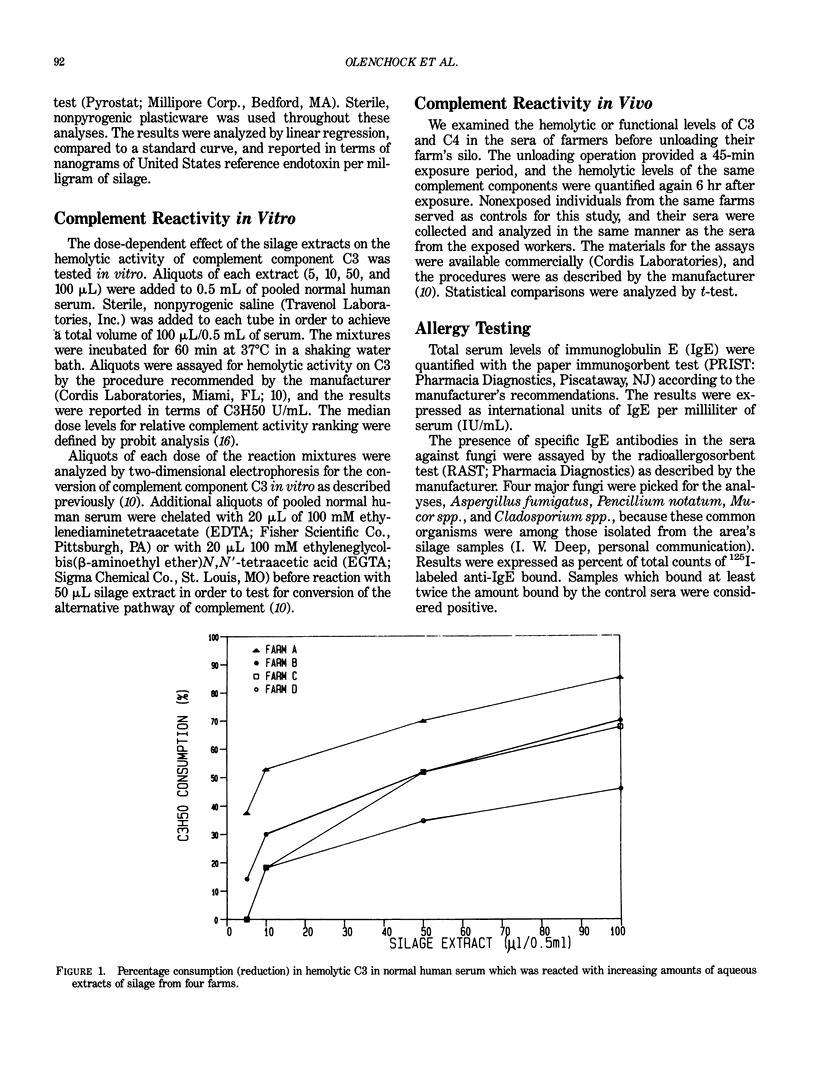
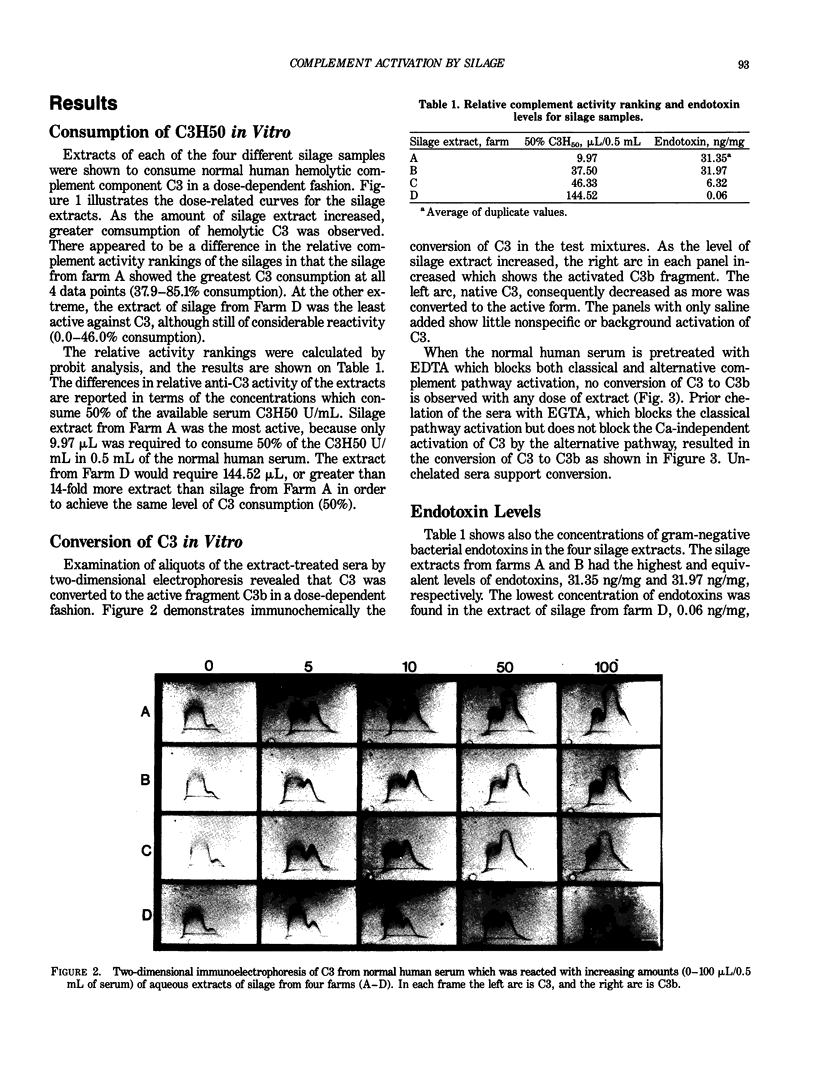
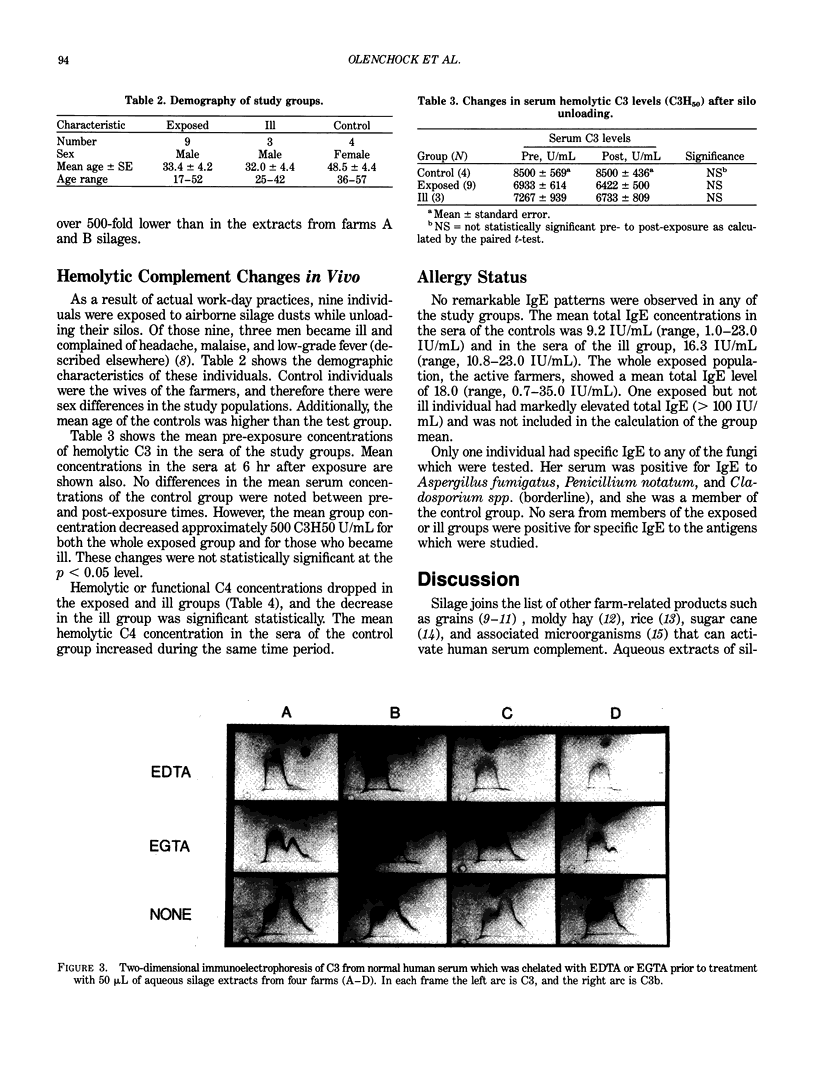
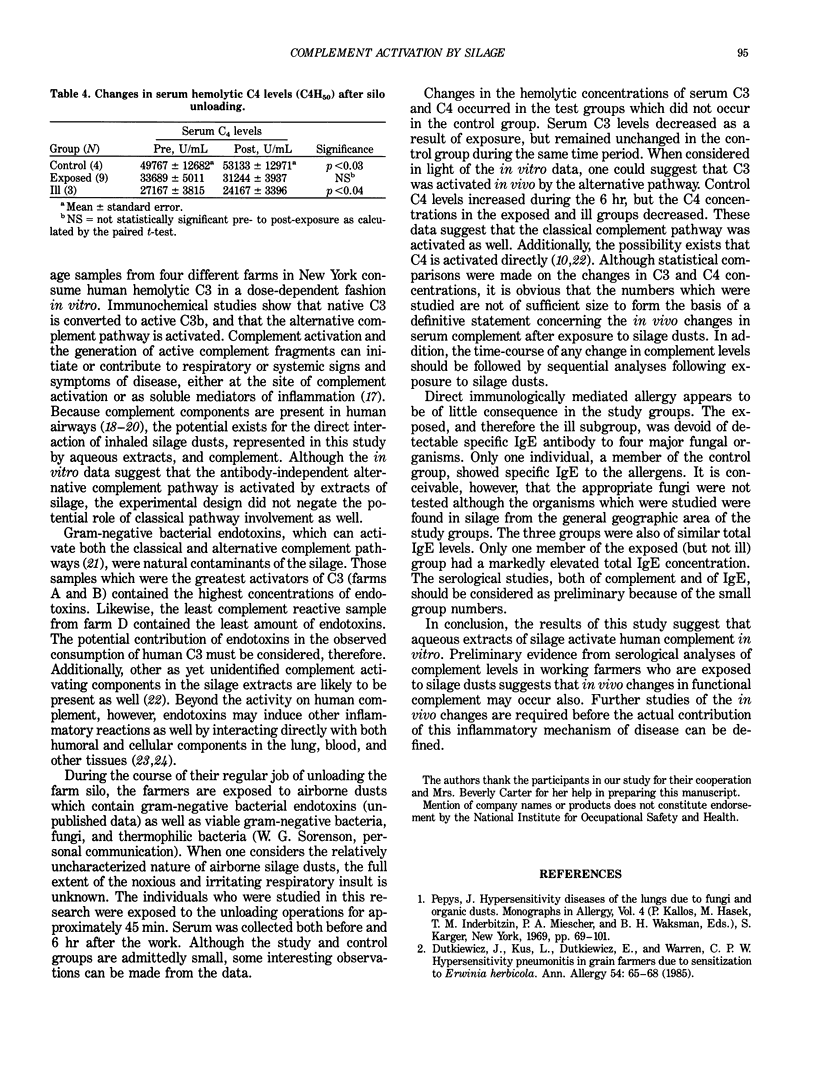
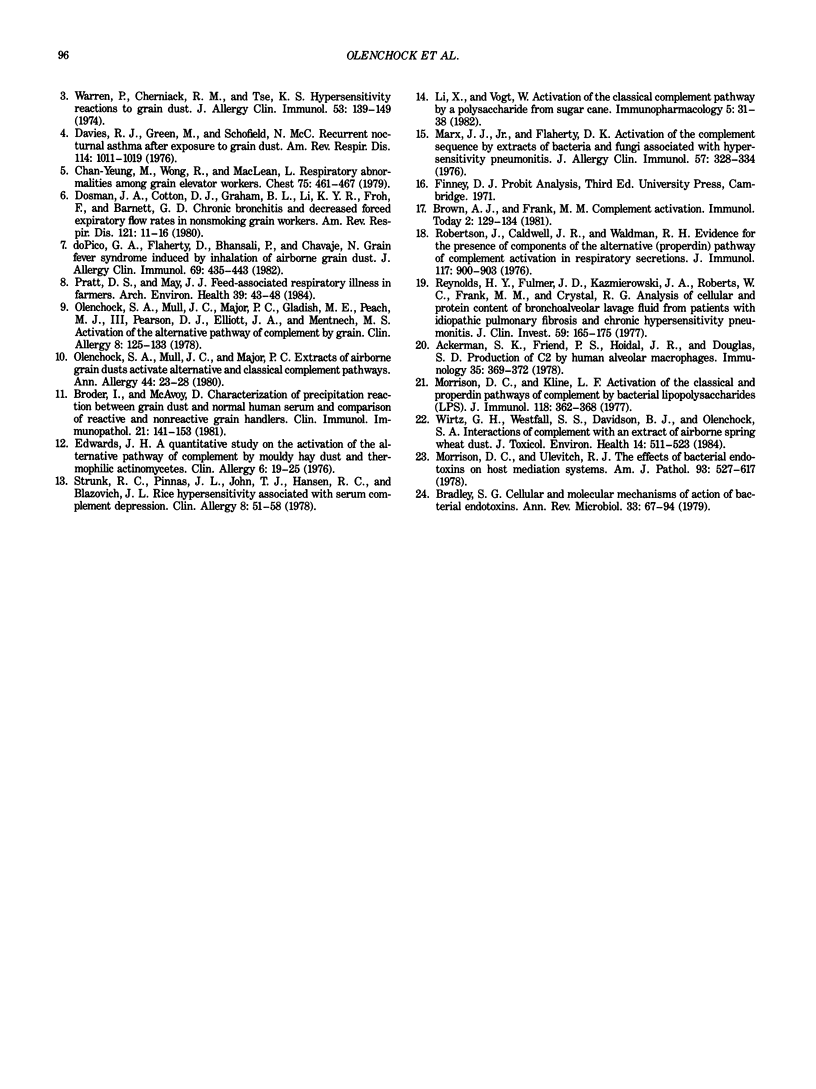
Images in this article
Selected References
These references are in PubMed. This may not be the complete list of references from this article.
- Ackerman S. K., Friend P. S., Hoidal J. R., Douglas S. D. Production of C2 by human alveolar macrophages. Immunology. 1978 Aug;35(2):369–372. [PMC free article] [PubMed] [Google Scholar]
- Bradley S. G. Cellular and molecular mechanisms of action of bacterial endotoxins. Annu Rev Microbiol. 1979;33:67–94. doi: 10.1146/annurev.mi.33.100179.000435. [DOI] [PubMed] [Google Scholar]
- Broder I., McAvoy D. Characterization of precipitation reaction between grain dust and normal human serum and comparison of reactive and nonreactive grain handlers. Clin Immunol Immunopathol. 1981 Nov;21(2):141–153. doi: 10.1016/0090-1229(81)90203-8. [DOI] [PubMed] [Google Scholar]
- Chan-Yeung M., Wong R., MacLean L. Respiratory abnormalities among grain elevator workers. Chest. 1979 Apr;75(4):461–467. doi: 10.1378/chest.75.4.461. [DOI] [PubMed] [Google Scholar]
- Davies R. J., Green M., Schofield N. M. Recurrent nocturnal asthma after exposure to grain dust. Am Rev Respir Dis. 1976 Nov;114(5):1011–1019. doi: 10.1164/arrd.1976.114.5.1011. [DOI] [PubMed] [Google Scholar]
- Dosman J. A., Cotton D. J., Graham B. L., Li K. Y., Froh F., Barnett G. D. Chronic bronchitis and decreased forced expiratory flow rates in lifetime nonsmoking grain workers. Am Rev Respir Dis. 1980 Jan;121(1):11–16. doi: 10.1164/arrd.1980.121.1.11. [DOI] [PubMed] [Google Scholar]
- Dutkiewicz J., Kus L., Dutkiewicz E., Warren C. P. Hypersensitivity pneumonitis in grain farmers due to sensitization to Erwinia herbicola. Ann Allergy. 1985 Jan;54(1):65–68. [PubMed] [Google Scholar]
- Edwards J. H. A quantitative study on the activation of the alternative pathway of complement by mouldy hay dust and thermophilic actinomycetes. Clin Allergy. 1976 Jan;6(1):19–25. doi: 10.1111/j.1365-2222.1976.tb01408.x. [DOI] [PubMed] [Google Scholar]
- Li X., Vogt W. Activation of the classical complement pathway by a polysaccharide from sugar cane. Immunopharmacology. 1982 Oct;5(1):31–38. doi: 10.1016/0162-3109(82)90034-0. [DOI] [PubMed] [Google Scholar]
- Marx J. J., Flaherty D. K. Activation of the complement sequence by extracts of bacteria and fungi associated with hypersensitivity pneumonitis. J Allergy Clin Immunol. 1976 Apr;57(4):328–334. doi: 10.1016/0091-6749(76)90089-0. [DOI] [PubMed] [Google Scholar]
- Morrison D. C., Kline L. F. Activation of the classical and properdin pathways of complement by bacterial lipopolysaccharides (LPS). J Immunol. 1977 Jan;118(1):362–368. [PubMed] [Google Scholar]
- Morrison D. C., Ulevitch R. J. The effects of bacterial endotoxins on host mediation systems. A review. Am J Pathol. 1978 Nov;93(2):526–618. [PMC free article] [PubMed] [Google Scholar]
- Olenchock S. A., Mull J. C., Major P. C. Extracts of airborne grain dusts activate alternative and classical complement pathways. Ann Allergy. 1980 Jan;44(1):23–28. [PubMed] [Google Scholar]
- Olenchock S. A., Mull J. C., Major P. C., Gladish M. E., Peach M. J., 3rd, Pearson D. J., Elliott J. A., Mentnech M. S. Activation of the alternative pathway of complement by grain. I. C3PA conversion and quantification of complement consumption by rye. Clin Allergy. 1978 Mar;8(2):125–133. doi: 10.1111/j.1365-2222.1978.tb00457.x. [DOI] [PubMed] [Google Scholar]
- Pratt D. S., May J. J. Feed-associated respiratory illness in farmers. Arch Environ Health. 1984 Jan-Feb;39(1):43–48. doi: 10.1080/00039896.1984.10545832. [DOI] [PubMed] [Google Scholar]
- Reynolds H. Y., Fulmer J. D., Kazmierowski J. A., Roberts W. C., Frank M. M., Crystal R. G. Analysis of cellular and protein content of broncho-alveolar lavage fluid from patients with idiopathic pulmonary fibrosis and chronic hypersensitivity pneumonitis. J Clin Invest. 1977 Jan;59(1):165–175. doi: 10.1172/JCI108615. [DOI] [PMC free article] [PubMed] [Google Scholar]
- Robertson J., Caldwell J. R., Castle J. R., Waldman R. H. Evidence for the presence of components of the alternative (properdin) pathway of complement activation in respiratory secretions. J Immunol. 1976 Sep;117(3):900–903. [PubMed] [Google Scholar]
- Strunk R. C., Pinnas J. L., John T. J., Hansen R. C., Blazovich J. L. Rice hypersensitivity associated with serum complement depression. Clin Allergy. 1978 Jan;8(1):51–58. doi: 10.1111/j.1365-2222.1978.tb00447.x. [DOI] [PubMed] [Google Scholar]
- Warren P., Cherniack R. M., Tse K. S. Hypersensitivity reactions to grain dust. J Allergy Clin Immunol. 1974 Mar;53(3):139–149. doi: 10.1016/0091-6749(74)90002-5. [DOI] [PubMed] [Google Scholar]
- Wirtz G. H., Westfall S. S., Davidson B. J., Olenchock S. A. Interactions of complement with an extract of airborne spring wheat dust. J Toxicol Environ Health. 1984;14(4):511–523. doi: 10.1080/15287398409530602. [DOI] [PubMed] [Google Scholar]
- doPico G. A., Flaherty D., Bhansali P., Chavaje N. Grain fever syndrome induced by inhalation of airborne grain dust. J Allergy Clin Immunol. 1982 May;69(5):435–443. doi: 10.1016/0091-6749(82)90118-x. [DOI] [PubMed] [Google Scholar]




